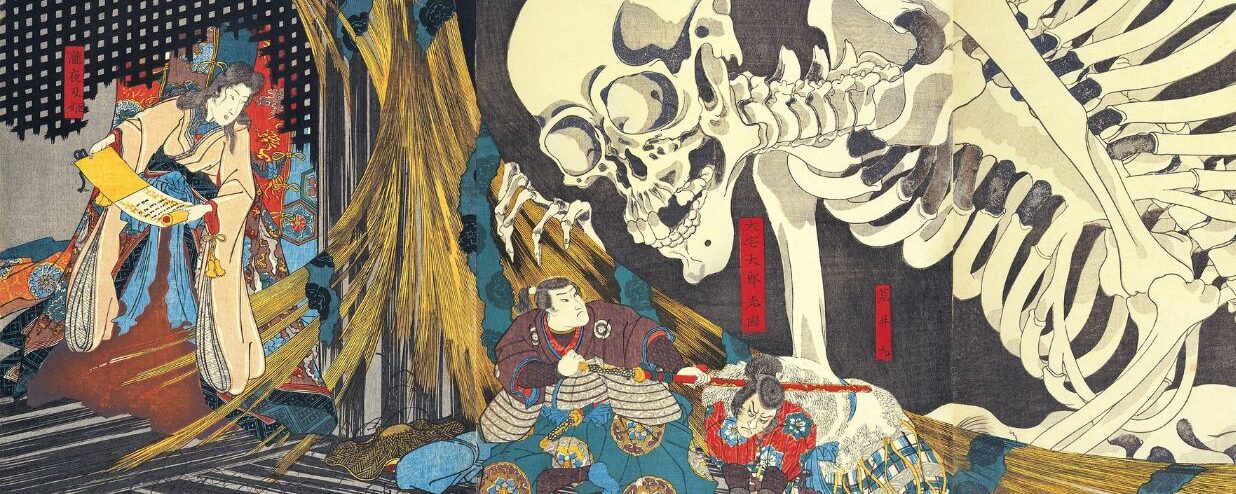What ghosts or creatures chronicled in Japanese folklore are lurking among the shadows, or perhaps hidden in plain sight? The mysterious and supernatural in Japan can take many forms, hidden in the most unexpected crevasses of your home, or may even be a friend that’s hiding a secret — even sinister — identity.
Discover what mischievous or malevolent ghosts, monsters, or other creatures to look out for. Be aware of their deceits and tricks, but also know which ones may actually bring good luck and fortune.
In this guide, we will introduce 15 frightening yurei or Japanese ghosts and other fascinating yokai from Japanese folklore and legends. This list may help explain certain superstitions in Japan and why you should, perhaps, believe them as well.
What are yokai?
Yokai does not have any specific English definition; rather, the word broadly describes the supernatural, magical, and mysterious entities found in stories, paintings, art, and literature throughout Japan. Yokai can include any creature, spirit, demon, living object, or other entities found across Japanese folklore. So all of the yurei and other mysterious entities we will discuss can be considered yokai.
If you want a deeper dive into the supernatural world of yokai, read our article detailing everything you need to know.
What is a yurei? Ghosts of Japanese folklore
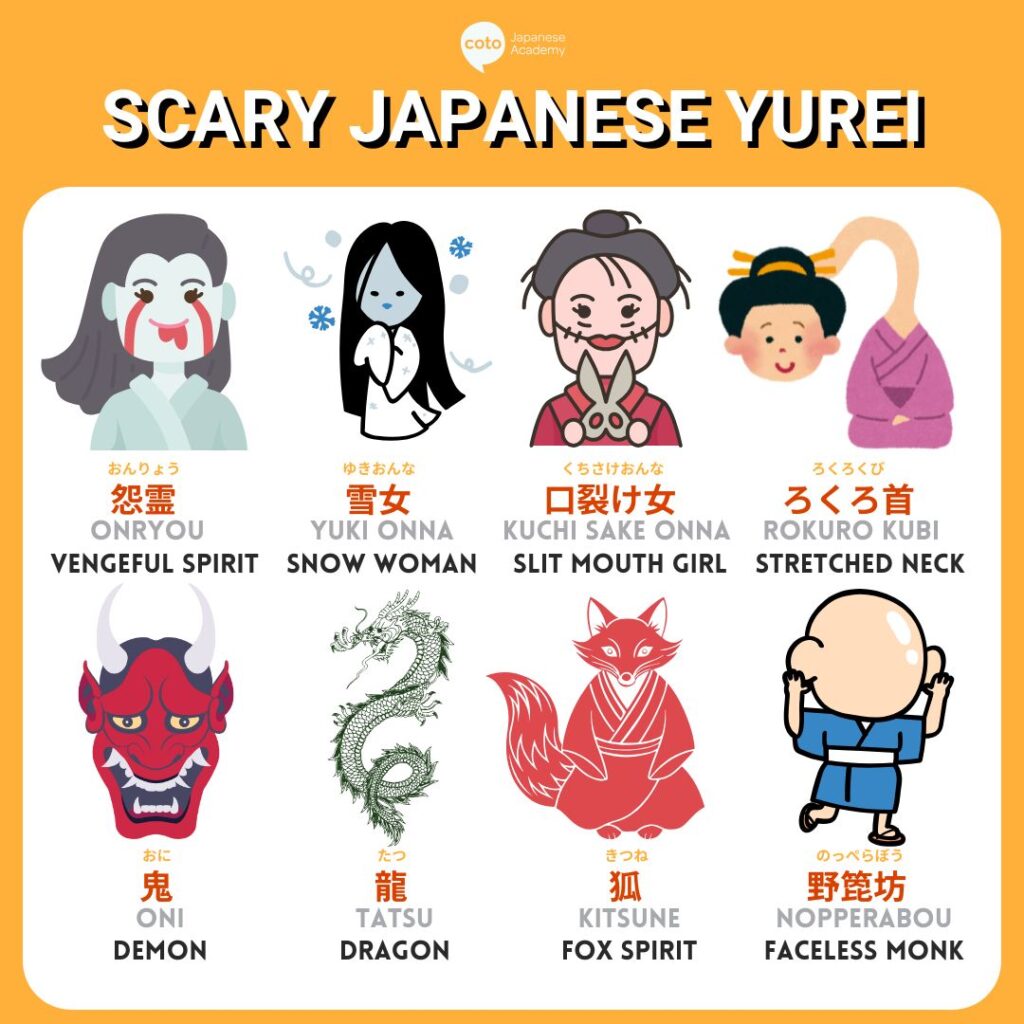
幽霊 (yurei) are similar to the western concept of “ghosts”, with 幽 (yuu or kasoke) meaning faint and 霊 (rei) meaning soul. They are often depicted wearing white robes, reflecting the old Japanese burial practices of burying the departed in white. Yurei are usually restless souls or spirits of the dead who have not been able to pass in peace. They are not able to rest due to anything unfinished, keeping them attached to the physical world.
Oftentimes, these spectres have remaining resentment, jealousy, and other strong emotions, causing them to torment the living, especially those they feel have wronged them. Sometimes they are quite vengeful and dangerous, but of course, not always.
In many stories with yurei, you have to listen to their wishes or concerns to help release them from their attachments, giving them peace of mind, and allowing them to disappear to rest in peace. There are many yurei found in Japanese folkloric stories, both dangerous and completely harmless.
15 Japanese Ghosts and folkloric creatures
Here is our very non-exhaustive list of 15 Japanese ghosts and other frightening entities you need to know about, especially before Halloween. Hopefully, this list alone will show you just how vast and deep Japanese folktales and myths can get.
1. 怨霊 (Onryo): Vengeful Spirits
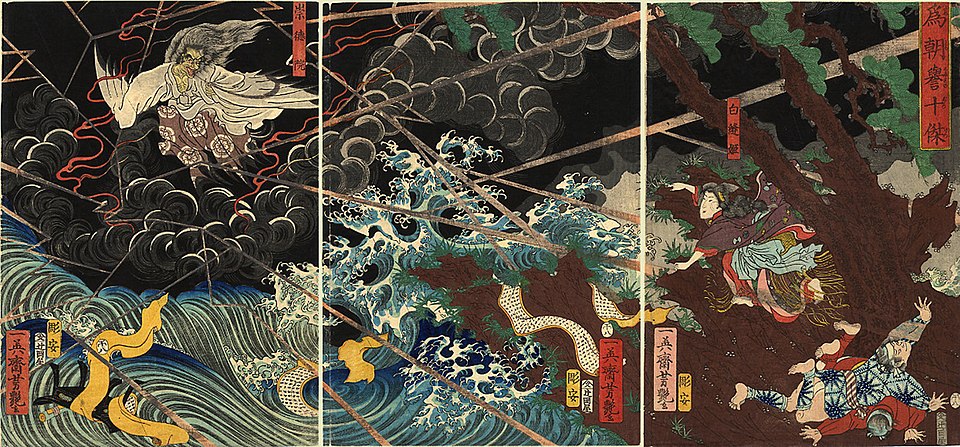
Onryo are vengeful yurei of people who had died with strong feelings of anger or hatred. Their grudges are so strong that they return as ghosts to exact revenge on those who wronged them, but more often than not, their wrath is indiscriminate, harming anyone in their vicinity. Stories depict them with great power, enough to bring earthquakes, fires, famines, pestilence, and other incredible disasters.
Even after they lie to rest, they are known to curse locations long after their time, making anyone who dares go near face a terrible fate. They can even curse family lines or all the future marriages, romances, and even children of an unfortunate individual.
Onryo are perhaps the most feared yurei in Japan, with many famous cautionary tales such as the Ghost of Oiwa from the Yotsuba Kaidan. Even to this day, her grudge can curse those who retell her story, which is why the whole cast and crew of the film adaptation visited her grave to pay respects.
2. 雪女 (Yuki Onna): Snow Woman
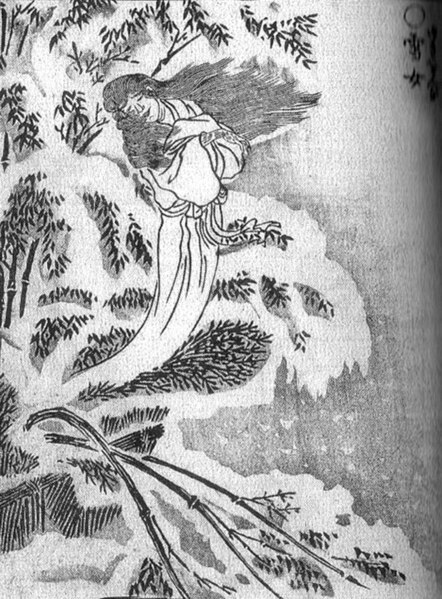
Yuki onna is a mysterious, ghostly figure that appears only in snowy regions, generally during snowstorms. She is often described as trapping men (usually) by making them fall in love with her or just simply freezing them to death. Sometimes she is likened to a succubus that sucks life force out of people, or as something mysterious with certain magical properties. Almost always, she’s depicted as very dangerous.
Tales have been told of yuki onna even before the Muromachi period (around 1336), with numerous stories and folktales found throughout Japan, portraying her from menacing to rather harmless. She is always described as having long black hair, piercing dark eyes, and skin so white it resembles snow. She is supposedly so beautiful that she must be otherworldly.
Kwaidan, an anthology film about yokai, tells one of the most famous and modern portrayals of yuki onna. In this story, she falls in love and shows sympathy for her lover, sparing him from harm despite his breaking his promise to her. This contrasts with her usual portrayals as cruel and void of emotion.
However, she is always mysterious and magical, disappearing into mist whenever she wishes and never revealing her true intentions.
3. 雨女 (Ame Onna): Rain Woman
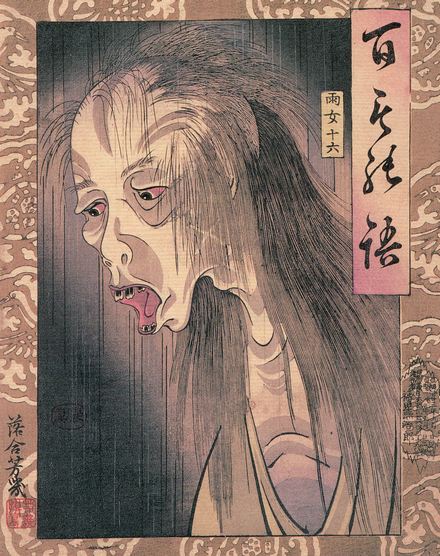
Ame onna is a ghostly woman who appears in the rain, or rather, brings rain wherever she goes. She usually has a crone-like, depraved, and almost ghoulish appearance that’s always soaked from the rain. She is often drawn licking the rain off her body, especially from her palms and arms.
They might bring fortune to villages suffering from drought, needing rain for their crops. However, their true intentions are to kidnap newly born girls, and if any are born the night they arrive, they will be taken away, never to be seen.
4. 骨女 (Hone Onna): Bone Woman
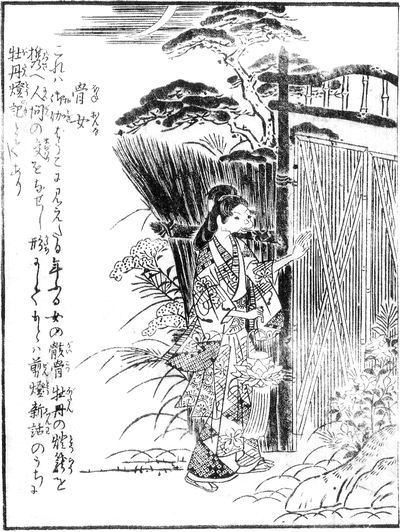
The hone onna literally translates to “bone woman.” This Japanese ghost is a yurei of a woman who has passed away but lingers in the land of the living in the form of a skeleton. In many tales, she is someone who died with strong feelings of love persisting after their death.
In many stories, the honne onna will seek out her lover, sometimes unaware of her own passing. In most stories her lover is overcome with joy at her return, causing him to only see her as she was when she was alive. However, others may see her in her true form, as a skeleton, and will try to warn her lover that she is truly back from the dead. But if he is never warned, he could continue seeing her until his life is drained, falling into death along with the woman he loves.
5. 口裂け女 (Kuchi Sake Onna): Slit Mouth Woman
The kuchi sake onna has perhaps the most unsettling appearance out of all the Japanese ghosts on this list. She is an onryo of a woman who had her mouth slit from ear to ear, giving her a menacing appearance. Thus, she has returned as a vengeful spirit to exact revenge on her wrongdoers.
This onryo seems to represent any woman who was killed in a particularly cruel fashion. Since they don’t rest well, they return to our world filled with rage. They often don’t just target their wrongdoers but any man they come across.
There are urban legends of them appearing as beautiful women asking if they are pretty, and if answered yes, they will reveal their true face. Then, if the victim says no or lies, the kuchi-sake onna will ensure they meet a gruesome fate. Only if someone honestly answers yes will they be spared.
6. 座敷童子 (Zashiki Warashi): Child Spirit
Zashiki warashi are the spirits of children, or at least resemble children. Zashiki actually refers to a sitting room covered in tatami mats. So they are basically house spirits that love rather harmless mischief. They usually make noises at night like children’s games and sometimes leave footprints all over the house. However, tales say that a house haunted by a zashiki warashi will have fortune and riches.
They are considered to be house guardians, and therefore, if you drive them away, you will bring ruin to your household. If you see signs of zashiki warashi, don’t kick them out. Many homes actually leave out candy to attract these friendly, luck-bearing yokai.
7. ろくろ首 (Rokuro Kubi) & 抜け首 (Nuke Kubi): Elongated Neck and Detached Neck
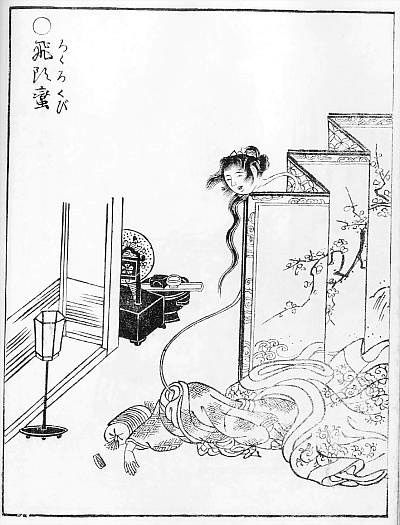
Rokuroku kubi appears to be a normal woman by day, but at night, her neck stretches and moves around freely. They are generally harmless, but they might scare people just to cause mischief. Unlike other Japanese ghosts, they are born as a normal woman but later get cursed as a rokuro kubi. In some cases, an unfortunate girl may never know she is a rokuro kubi her whole life, but once discovered by others, she will be quietly ostracized and treated poorly.
Nukekubi are a type of rokuroku kubi, except their head completely detaches from the body, allowing their head to travel further distances. They also tend to be more malicious, thirsting for blood and human flesh, thus often feeding on people or animals. Nukekubi also seems to be cursed, but with something much darker than rokuro kubi.
8. 野箆坊 (Nopperabou): Faceless Monk
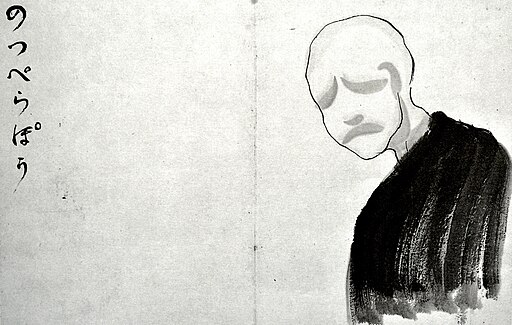
Nopperabou appear like any normal person in every way… except that they have no face. Their only goal seems to be to strike fear into people. They frequent roads late at night, facing away from their victims, only to turn around when approached to reveal their true, faceless form. Some may even pretend to have a face, especially of someone their victim knows, only to wipe it away with their hand.
Beyond their propensity to terrify people, they don’t seem to be very dangerous. It is unknown what these creatures really are, but some believe they could be mischievous shape shifters like the kitsune.
9. 狐 (Kitsune): Fox Spirit
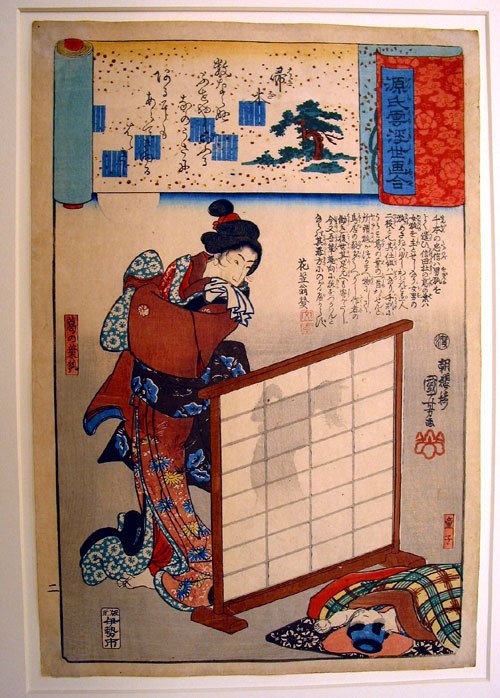
Kitsune literally means “fox”, but in Japanese folklore, the fox is a majestic, supernatural being ranging from spirits to even something like a deity. They are very intelligent and are known to be tricksters, making people lose their way or tricking them into strange activities. Although they can be devious or even malicious and vengeful, they are also presented as loyal, remembering friendships and keeping their promises. If good is done to them, they will do good to you too.
They are also known as shape shifters who can transform into humans or giants and other large creatures. In many tales, they transform into a beautiful woman who marries a man. They sometimes trick the man by taking everything he has and bringing shame to him, or they genuinely love him but cannot have him discover their true identity.
In Shinto legends, kitsune serve the deity, Inari, with their shrines decorated with statues of them. They are messengers between the gods and the human world. Sometimes, they give wisdom to humans deserving of it. They are said to bring good fortune and even protect different places or people, warding off any evil.
Other tales of the kitsune have their origins in Chinese folklore. These kitsune are said to have more power the older they are and by the number of tails they acquire. The most powerful of which is the 9 tailed fox. If you watch anime to learn Japanese, you will probably get this reference from Naruto!
10. 狸 (Tanuki): Raccoon
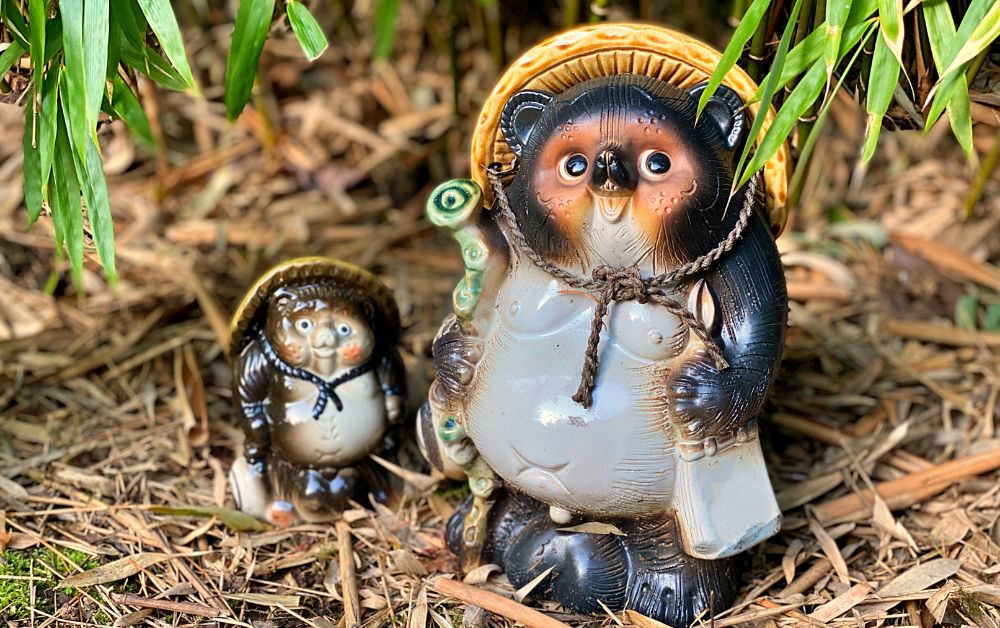
Tanuki somewhat translates to “raccoon” in English, but they are a unique species to Japan and East Asia (check here for other animals in Japanese). In folklore, they possess magical powers similar to those of a kitsune due to their shape-shifting abilities. They also seem to have a reputation for being mischievous, tricking humans from time to time, but they are known for their friendly nature and even revered for their abilities.
In ancient tales, Tanuki were considered to be the gods of nature as well as messengers for the gods. However, after Buddhism was introduced to Japan, their reputation as a sort of deity faded. They were still presented as very powerful, able to shapeshift into people and live among them without ever being noticed. They can even transform into objects if they wish.
Generally, tanuki are good-natured and enjoy the company of humans. However, like humans, they each have their personal traits. Even when they are in human form, they can fall into the same vices such as lying, cheating, or stealing. They may even use their magical powers to do great harm to humans.
11. 首かじり (Kubikajiri): Head Eaters
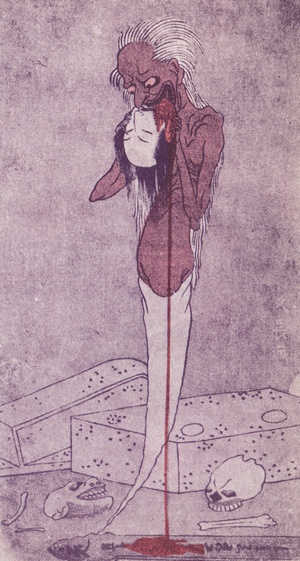
While the literal translation of Kubikajiri is “neck biters”, they actually are ghostly entities that feed on the heads of corpses. They look old, balding, with hair falling out, discolored skin, and sunken eyes. They look like the Japanese ghost of the undead, of something that is tired and desperately hungry for heads.
This yurei is said to come from the restless souls of the elderly who were left starving to death by their family during times of famine or economic hardship. Their resentment for being treated as a burden and neglected causes their souls to return as a Kubikajiri. Then, once their family who wronged them has departed, they will find their graves and feast on their heads.
12. 魑魅 (Chimi): Mountain spirit
Chimi is the general term for spirits found in the mountains, woods, rivers, lakes, and other natural places in Japan. They have human-like faces but bestial bodies, crawling on all fours. They tend to eat human corpses and can be quite dangerous, leading people off their path, isolating them to be killed and eaten. Some can even be pure evil, bringing disease to populations. The most evil of them are called Jami or “evil spirits”.
13. 鬼 (Oni): Demon
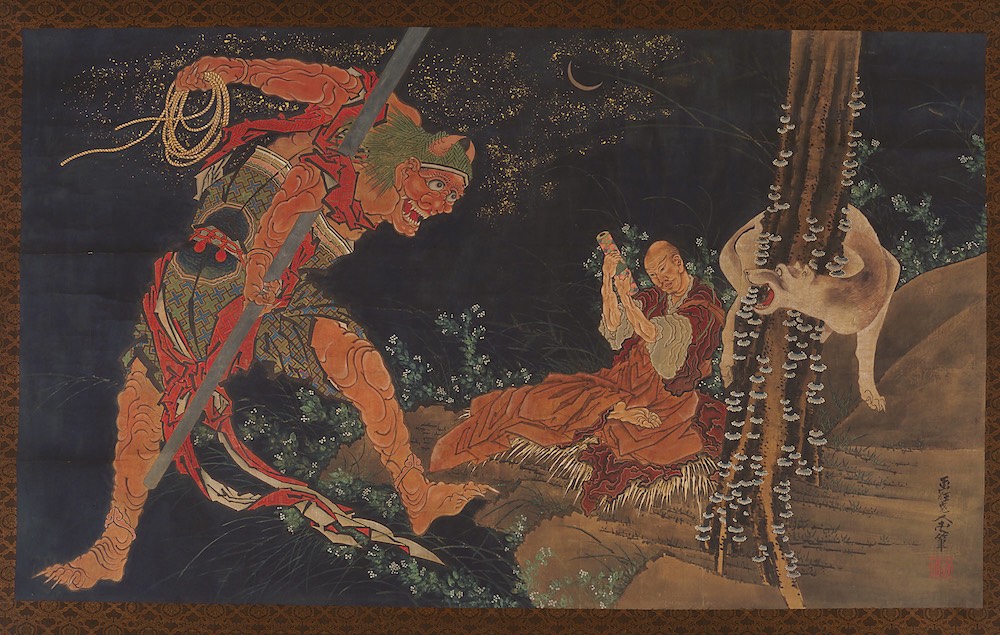
Perhaps one of the most famous Japanese folklore, oni, once described all Japanese ghosts, or monsters, but over time has come to describe demons, ogres, or evil spirits created in hell to punish the wicked. Oni usually possess supernatural powers, wielding dark magic that can bring disaster, disease, or thunder and lightning. They are also giant, larger than any human, and much stronger. Their appearance is very menacing; usually, they have red or blue skin, large horns, and teeth.
Oni are usually born in hell or found deep in the mountains; however, if a man is wicked enough, they can be transformed into an oni to torment the living. These are the ones most legends talk about and pose the greatest danger to humankind.
There is a vast literature, artwork, and stories told of Oni and their destructive power against humans; however, they seem to have a profound impact on Japanese culture as well. Their imagery can be found throughout Japanese culture as masks worn in plays and festivals or worn by samurai to strike fear into the heart of their enemies.
Oni are often shown to be evil and malicious, but sometimes are depicted to be protectors, even bringing good fortune, especially in modern times.
14. 死神 (Shinigami): Death Spirit
Shinigami literally translates to “god of death,” but actually broadly refers to creatures or spirits that possess people to drive them to death. They are particularly drawn to places of evil, or locations with a history of death and human suffering, like graveyards or battlefields.
They are generally believed to cause cycles of tragedy in specific places, which will continue until the area or person is sufficiently exorcised. Shinigami love to linger in areas tainted with evil, waiting for someone to haunt, especially people who are particularly wicked, since once processed, they will obsess over every wrongdoing they have done and long for death.
15. 龍 (Tatsu): Dragon
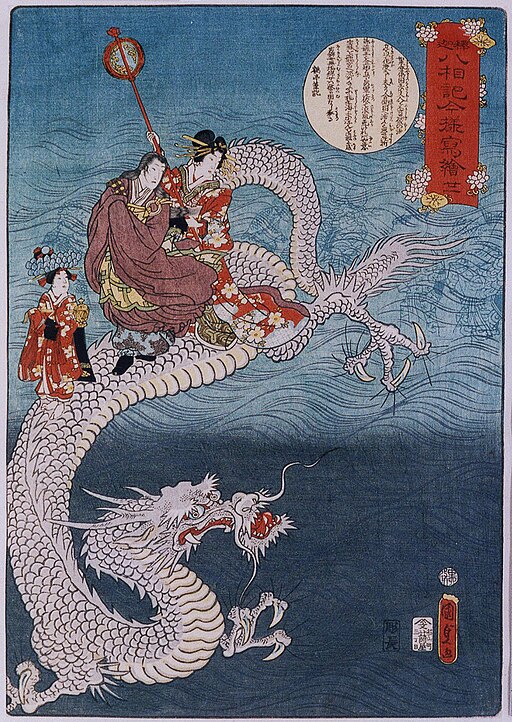
Tatsu are Japanese mythical dragons, very similar to the legendary dragons of China, with long serpent-like bodies, long claws, and faces with long horns or antlers and beards. They are some of the most revered creatures in Japanese mythology, often considered to be like deities, with people honoring them with festivals, pilgrimages, and prayers.
They are highly associated with rivers, waterfalls, seas, and mountains, making homes there, usually secluded away. Like western dragons, they are known to hoard treasure and magical artifacts in their homes. However, they are usually seen as pure and good, offering wisdom and magical gifts to those who are worthy. There are also tales of a very malicious Tatsu who tormented humans out of spite. So, Tatsu can also be a terrifying and powerful villain.
Closing Up: More Japanese ghosts to discover with Coto Academy!
This list of fascinating yurei and other supernatural creatures is just the tip of the iceberg. There are perhaps thousands of different yurei and yokai to discover! As you read more about these intriguing tales, you may discover more about Japanese culture that you never knew, and even see how history is preserved even to the modern day.
At Coto Academy, we believe language learning goes hand-in-hand with cultural discovery. Want to dive deeper into yurei legends and even read spooky stories in Japanese? Our classes are designed to help you engage with real, authentic Japanese culture, folklore included! Check out Japanese courses at Coto Academy and sign up today! Fill out the form below for a free level check and consultation.
FAQ:
What are yurei?
Yurei are similar to the English word “ghost” and behave in similar ways. They are the spirits of those who have departed and often linger in the land of the living due to something unfinished. Like our ghost stories, they could be vengeful or harmless but may disappear once they find closure.
Are there different types of yurei?
Yes, there are several types of yurei, the most infamous of which are Onryo, vengeful spirits, as well as more harmless ones such as Zashiki Warashi, child-like spirits who enjoy candy. There are many others, such as the spirits of those who passed from battle, nobles who passed too early, and so much more.
What is the difference between yokai and yurei?
Yokai is an even broader term encompassing just about any supernatural or majestic entity originating from Japanese folklore, legends, and myths. Yurei generally refers to spirits of those who once lived.
Do yurei possess any powers?
Some yurei in certain tales do seem to possess certain powers, whether it’s magic to cast curses, abilities to disguise as the living, possess the living, and more. A great example of a yurei with great power is the Yuki Onna, generally having powers such as being able to freeze people with her breath.
Are all yurei evil? Or are there good yurei?
While there are many examples of very harmful yurei, there are plenty of yurei who are completely harmless. For example, the zashiki warashi or child spirits actually bring good fortune to the homes that welcome them. Many times, yurei may seem mischievous but may just be misunderstood.
What is Japanese ghost called?
A Japanese ghost is called a yurei (幽霊).
Is oni a Japanese ghost?
Oni are not ghosts but demonic ogres or trolls in Japanese folklore.
Want more spooky or autumn-related content? You might like:
